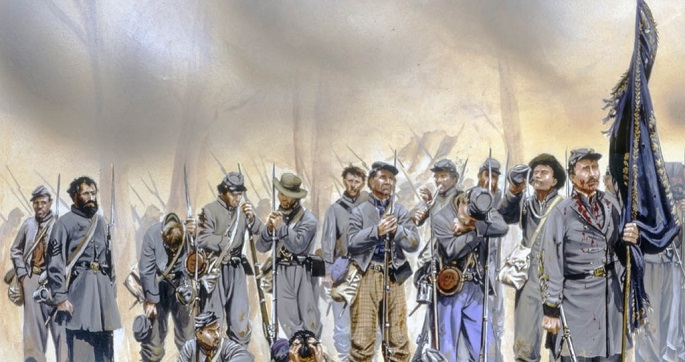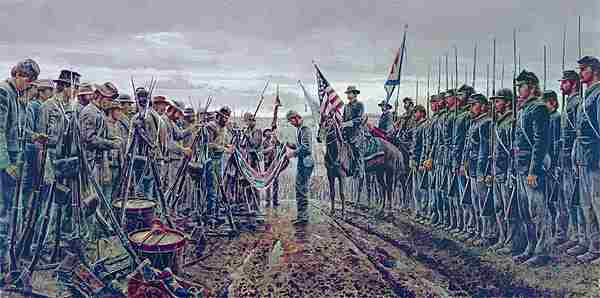The 22nd Virginia Infantry was a western Virginia infantry regiment that served in the Confederate States Army during the American Civil War. Its commander was George S. Patton, Sr., grandfather of World War II General George S. Patton.
In addition, three other divisions were reassigned and did not fight this block. The Charleston Rifles (also called Swan’s Company) were organized by Charleston lawyer John Sterling Swann in December 1859 and worked alongside the Kanawha Rifles until secession. After being commissioned on April 25, 1861, they were transferred and drafted into the Confederate States Army as Company K of the 59th Virginia Infantry in July, then detached to form Company A of the 26th. Infantry of Virginia.

The Kanawha Artillery (also called Hale’s Battery) was organized in Charleston by Dr. John Peter Hale, who also funded it at the suggestion of the then Colonel. John McCausland. Their new gun, commissioned in Virginia in June 1861, supposedly changed the Battle of Scary Creek on June 3, although Lieutenant James Clark Welch was the unit’s (and possibly the South’s) first casualty. By July, she had become Captain Thomas E. Jackson’s Virginia Light Artillery Company.
Service
The 22nd saw action at Carnifex Ferry and later lost 21% of 550 engaged at Drup Mountain. He was assigned to the brigade of Echols and Patton, participated in operations in the Shenandoah Valley and disbanded in the spring of 1865.
In 1859, the militia unit permanently changed its name to the Ditch Gunners. When the Civil War began in West Virginia, the 22nd was known as the 1st Kanawha Rifles upon the Confederate commission in June 1861. The 22nd Regiment was formed under the command of Captain Patton. Later, Captain Patton was appointed colonel of the 22nd Virginia Kanawha Army under the command of General Henry Wise, a former governor of Virginia.
The first baptism of fire took place on July 17, 1861 at the battle of Terrible Creek. Captain George Patton scored a major victory for the Confederates and he was wounded in the shoulder and left in Charleston, West Virginia. During his absence, the 22nd Virginia was placed under the command of Colonel Christopher K. Tompkins.
Infighting between Wise and John B. Floyd (also a former governor of Virginia who was sent to the Kanawha Valley) and unrest in the Confederate troops led President Jefferson Davis to send General Robert E. Lee to the region for oversight.
After a weak assault on Mount Sewell, General Lee ordered General Wise to be expelled from West Virginia and transferred to North Carolina. General Lee then decided to transfer the 22nd to General Floyd’s army in Southwest Virginia.
In early 1862, after the Romney campaign, Floyd crossed into Tennessee and General Henry Heth became commander of the Army of the New River in the Department of Southwest Virginia under General William W. Loring. A small force was victorious at the Battle of Giles Court House on May 10, 1862, but was quickly defeated at the Battle of Lewisburg on May 23, 1862. General Heth was greatly disliked by members of the 22nd Virginia. The reasons for this dislike began in Lewisburg. General Heth misjudged the strength of the Union army under General Crook, resulting in the ultimate disaster. During the battle, the Union army managed to get hold of a Confederate cannon that dates from the Revolutionary War and was the cannon that the British surrendered at Yorktown. In the end, it all ended when General Heth’s army began to disobey orders.
Heth’s men returned to New River to continue protecting the vital railroad bridge. They were then sent west to the East Tennessee Department to serve under Edmund Kirby Smith. During the Kentucky campaign, he was sent by Smith to take a division north of Lexington, Kentucky to demonstrate in Cincinnati; although this caused a great commotion in the city’s defenses, only a few skirmishes occurred.
Part of Smith’s army was dispersed too far north in Kentucky to link up with part of Bragg’s army in time for the Battle of Perrisville. Bragg ordered Confederate troops to be withdrawn back to Tennessee, and Smith was subsequently transferred to the Trans-Mississippi Department, his forces once again missing the vital battle of the Stones River.
While the Chancellorsville campaign was underway, General Heth was recalled to Lee’s Army of Northern Virginia, and General John Echols converted the New River Army into the Army of Southwest Virginia in the spring. 1863 The 22nd Virginia spent the spring in a series of raids called the Jones and Imboden Raid. The raid went all the way around West Virginia and entered Oakland, Maryland. The purpose of the raid was to destroy the sheds where the B&O Railroad was vital. On April 24, the raid moved to Beverly, West Virginia. After settling in Beverly, the 22nd Virginia was involved in a skirmish that resulted in the capture of several Union soldiers and supplies. During August, the 22nd Virginia was near Lewisburg. White Sulfur Springs was the site of a famous health resort and the scene of a huge battle between the 22nd Virginia and federal troops under General Averell.
The Battle of Drup Mountain took place on November 6, 1863.
At dawn, the Union army under General Averell sent out skirmishers to check the Confederate line. The Confederates held positions there, and this forced General Averell to send a detachment of troops to the west, where they were ordered to attack the Confederate left. Echols was aware of the situation, even though the right and right had been reinforced, and ordered the left flank to be reinforced. Sending the 23rd Virginia Battalion to support the Confederate left. Seeing the Confederate right and center in retreat, Echols sent three companies of the 22nd Virginia to support the left flank. Patton informed Echols that the left flank was on the verge of collapse. When the Confederates were ordered to retreat, Colonel Jackson held the center for another half an hour until the artillery was removed from the battlefield. The Confederates retreated into the woods and out of sight. Despite the fact that the Battle of Droop Mountain was a Confederate defeat, Echols managed to survive the Union Army’s main thrust and prevented Averell from completing his foray into Virginia and Tennessee.
After the Battle of Drup Mountain (West) Virginia in November 1863, the Army of Southwest Virginia was nearly annihilated. In 1864, the 22nd Virginia was assigned to General John C. Breckinridge to defend the Shenandoah Valley from invading Federals. In May at New Market, Virginia, the 22nd placed next to the V.M.I. tournaments, the 22nd’s biggest win yet. By late spring, the 22nd Virginia was called to Richmond, Virginia to take part in the defense of the Confederate capital at Cold Harbor, as Grant’s army again invaded the state, this time without retreating as previous generals had done in the past. West Virginia would never again be claimed by its mother state of Virginia, and General Lee desperately needed men. This led to the withdrawal of the 22nd Virginia Infantry from West Virginia.
By the summer of 1864, the 22nd Virginia went with the Army of the Valley to deliver the Yankees under General Franz Siegel of Lynchburg, Virginia. They also entered the Shenandoah Valley to slightly ease the pressure on General Lee’s lines and force Grant to send troops from Petersburg. Consequently, the 22nd Virginia will soon become part of the raid that will attack Washington, DC. The 22nd Virginia left Petersburg in June 1864 to attack the Federals and ease the pressure of federal occupation of the city. The first task was completed with the release of Lynchburg. General Jubal Early then traveled up the Shenandoah Valley and entered Maryland at Shepherdstown, West Virginia.

Once there, the raid moved to Hagerstown demanding $20,000 from the city.
The officer in charge misunderstood the order and accidentally forgot to add an extra zero to that number. On July 8 at Turners Gap, near Middletown, Maryland, the 22nd Virginia engaged in a series of skirmishes that finally ended late in the evening in Frederick, Maryland. On July 9, 22nd, Virginia served as a reserve during the Battle of Monocacy. On July 11, the 22nd, Virginia was called to Fort Stevens, three miles from the White House. For the next
